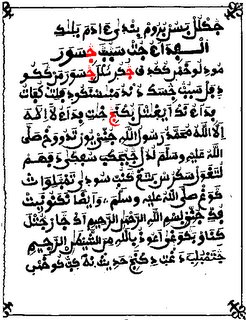
With apologies for the long hiatus in my postings, I would like to present another topic in West African writing: the surprisingly formalized tradition of writing Wolof, the main language of Senegal, in Arabic script. Wolof is also written in Latin script, I should note, which you can see copious examples of in the pedagogical materials on this Gambian Peace Corps site, but the Arabic script is much more widely known, especially in rural areas, although French is far more widely used for writing than Wolof in any script.
Myself, I only went to Dakar, so books in Wolof of any sort were relatively hard to come by. However, Arabic bookstalls, while rarer than the French ones, weren't hard to find (they had a predominantly religious focus, but a number of literary, scientific, and historical works), and, while most of their works were in Arabic, they had a couple of Wolof religious texts in a rather nice Arabic script, of which I enclose a scan. I was going to retype some, but even a cursory effort revealed serious issues. For instance, there is a Unicode letter for the common West African vowel sign that indicates short e (a dot under the letter, smaller than dots that form part of the letter) - the charts say it's 065C - but I can't find a font that will display it; and another common letter which seems to indicate ny or nj, jiim (ج) with three extra dots on top, isn't in Unicode at all. Apart from those, the main differences with standard Arabic seem to be:
- Short e is as described previously; long e is indicated by adding an alif maqsura ى with a small alif on top (another character I can't seem to find fonts for, despite its commonness in the Qur'an; it should be 0654.)
- p is a ba ب with three dots on top (and actually is in Unicode - 0751.)
- A dal with three dots above (ڎ) occurs some places; I don't know how it's pronounced.
- gaaf is a kaaf with three dots (ڭ), following longstanding Maghrebi tradition.
- Again in the Maghrebi tradition, faa has its dot below, and qaaf has a single dot above.
PS: You can find a font that will display some of these letters at PakType; however, their selection is more adapted for Sindhi (which has the largest Arabic-based alphabet I know of) than for West Africa.
PPS: Apparently, the latest version of PakType can display all these after all; see comments...
4 comments:
Ah, you allow anonymous posting now.
Which Paktype font did you try? The latest version of Paktype Tehreer seems to have all the characters you mention in Unicode. (U+065C ARABIC VOWEL SIGN DOT BELOW seems to force characters into independent or final form, though. This may be a problem with my rendering engine rather than the font - the same thing happens with other fonts.)
U+065C ARABIC VOWEL SIGN DOT BELOW (ٜ)
U+0751 ARABIC LETTER BEH WITH DOT BELOW AND THREE DOTS ABOVE (ݑ)
U+068E ARABIC LETTER DUL (ڎ)
U+06AD ARABIC LETTER NG (ڭ)
U+06A2 ARABIC LETTER FEH WITH DOT MOVED BELOW (ڢ)
U+06A7 ARABIC LETTER QAF WITH DOT ABOVE (ڧ)
Short e is as described previously; long e is indicated by adding an alif maqsura ى with a small alif on top (another character I can't seem to find fonts for, despite its commonness in the Qur'an; it should be 0654.)
I'm a little confused by this - perhaps just a matter of my ignorance of Arabic. U+0654 is ARABIC HAMZA ABOVE, U+0670 is ARABIC LETTER SUPERSCRIPT ALEF. Both of these are in the font.
No sign of that jiim with three dots above, though.
If you don't like the PakType font, or have any problems with it, there are a couple of SIL fonts I just found recently that should cover all the same points.
-- Tim May
Thanks! I was using an outdated version of the font, it turns out. The SIL fonts are a good find.
Where is the scan?
I think the 'jeem with three dots above' is really a 'hah with three dots above' (څ) and the 'vowel sign dot below'
Post a Comment